Application of ultrathin free-standing supports in chemical analysis of ultrathin organic layers.
Duration: 2016 - 2021

The proposed project will investigate the phenomena occurring during bombardment of the ultrathin sample with three distinct types of projectiles. It will contribute to the development of Secondary Ion Mass Spectrometry (SIMS) research method.
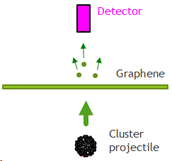
SIMS is the method where you hit the sample with charged particles called ions. Those particles begin chain reaction in the sample which results in emission of different ions coming from the sample, called secondary ions. Secondary ions are detected using mass spectrometer which later lets researcher find what was the com- position of the investigated sample and how atoms where placed in it. SIMS is a very sensitive technique providing information about femtomoles of compounds.
It is like detecting amounts of compound of the size of single virus. SIMS has also very high resolution giving information from area as small as 50 nm x 50 nm which is again the size of a small virus. Unfortunately, there are some drawbacks to the technique which we want to address.
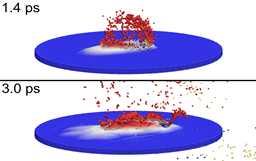
SIMS cannot give easy to analyse information about compounds of higher mass than 1500-2000 u. It is enough for most inorganic and polymer studies but far too small for biological ones. Proteins, which life on Earth is built from, have masses from tens of thousands to even millions u. Nowadays big molecules are torn apart during bombardment of the sample. We will investigate a method for lifting big molecules from the surface intact with the use of ultrathin graphene supports. This research could lead to breakthrough in usage of SIMS in applications involving organic molecules.
Another issue with the SIMS method is its sensitivity to chemical surroundings of the emitted compounds. Even single oxygen atom can drastically change the signal from distinct molecules, strengthening or weakening it by several orders of magnitude. Because of this SIMS cannot give quantitative information on the com- position of the sample. We can say that there is specific thing in the sample but cannot tell how much of it. There is a solution for the problem through special preparation of the sample such as molecules are spread out far away from each other so they do not interact with anything on the surface of the substrate. Still, this method gives very small signal additionally obscured by atoms coming from the substrate. We will research the possibility to use the graphene support which would result in much less material emitted from the substrate and as such much less distorted signal from molecules on its surface.
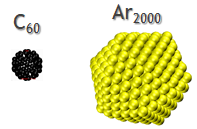
Last but not least, we will investigate processes involving three different projectiles that could give high rates of ionization of the emitted material. Not everything that comes out of the sample can be detected in mass spectrometer. Only compounds that have charge on them, ionized ones, are visible for the apparatus. Having more ions means a stronger signal, better resolution and higher sensitivity. In the project we will use projectiles in the form of Buckminster fullerene cluster C60, gold cluster Au400 and hollow atom type of projectile. Cluster projectiles are widely used for desorption of bigger molecules and higher ionization rates. Both C60 and Au400 clusters behave differently and exhibit distinct mechanisms when hitting the sample. Mechanisms involving both of them will be investigated and compared to find the best system for desorption of big molecules. Hollow atom projectile, on the other hand, is a completely different type of projectile consisting of single, highly ionized atom with all electrons in the excited states. Its unusual electronic state raises unique interactions with the sample giving opportunity for innovative solutions for the abovementioned SIMS problems.
The successful research will lead to enhancements in SIMS technique enabling it for use with big organic molecules and boosting its already high sensitivity and resolution. Intermediate investigations will be useful as well as they will provide insight into mechanisms of graphite sputtering which are still not researched almost at all. Considering the recent uprising of the graphene interest in both science and technology, these investigations will be of high value.
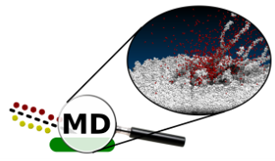
All of the research in the project will be performed using computer simulations. Molecular dynamics (MD) methods will be used which let us simulate systems with millions of atoms. Computer simulations are very powerful technique giving information about interactions and time scales that are unavailable or extremely difficult to acquire through experiments. They also let us do computations changing many variables which would require access to several different experimental setups and result in large costs. Computations will be held in super- computer facilities in Poland and USA.
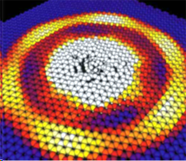
Abnormal modifications of DNA chemical structure and composition, so-called DNA damage, may appear spontaneously or upon interaction with various damaging factors. Each cell is exposed to approximately 8000 DNA damage cases per one hour. DNA damage types might include missing bases or their chemical modifications, formation of the pyrimidine dimers, single strand breaks (SSBs), and the most dangerous for cells double strand breaks (DSBs). Unrepaired or repaired incorrectly DSBs may lead to chromosomal aberrations, mutations, or cellular death. Cells develop various DNA repair mechanisms, which have to work incessantly for the maintenance of the genomic integrity. Although the enzymology of DNA damage repair was intensively studied, many fundamental, structural aspects of DNA repair still remained elusive, such as the structures and orientations of protein complexes against DNA. Very important is the role of local conformational DNA transitions upon damage induction, or interaction with the repair proteins. DNA conformation determines the nature of interaction between DNA and the repair proteins. Therefore, local conformational transitions seem to play a key role in DNA repair processes. Apart from the induction of DNA damage and interaction with the repair proteins, the complex chromatin structure affects the susceptibility of DNA to changes of the conformation. Due to methodological limitations the local DNA conformational transition upon repair process is very poorly understood. Based on the existing knowledge, the following scientific hypothesis can be formulated: DNA conformation and chromatin integrity determine the susceptibility to DNA damage and repair. In the proposed project we are going to prove this hypothesis and complete the following project objectives: i) direct, experimental verification of the DSBs chemical structure inducted by bleomycin, ii) detailed description of the chemical bonds formed between DNA/chromatin and repair proteins, iii) understanding an influence of DNA methylation on the local DNA conformational transition, iv) development and optimization of DNA/chromatin nanoscale structural imaging in a liquid environment, v) monitoring, in real time, molecular changes of single DNA/chromatin strands upon bleomycin and introduction of repair proteins into the solution during nano-spectroscopic mapping, vi) finding molecular markers of cellular response to bleomycin treatment, especially related to synthesis of the repair proteins.